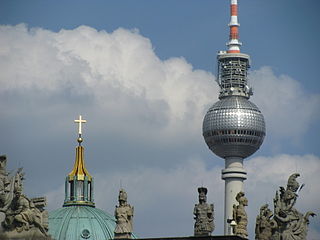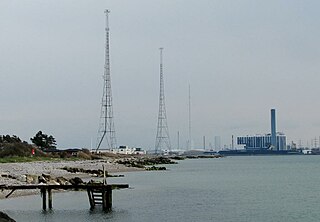
The Fernsehturm in central Berlin was constructed between 1965 and 1969 by the government of the German Democratic Republic, or East Germany, as both a functional broadcasting facility and a symbol of Communist power.

The Berliner Funkturm or Funkturm Berlin is a former broadcasting tower in Berlin, Germany. Constructed between 1924 and 1926 to designs by the architect Heinrich Straumer, it was inaugurated on 3 September 1926, on the occasion of the opening of the third Große Deutsche Funkausstellung in the grounds of the Messe Berlin trade fair in the borough of Charlottenburg-Wilmersdorf. Nicknamed der lange Lulatsch, the tower is one of the best-known points of interest in the city of Berlin and, while no longer used for broadcasting purposes, it remains a protected monument.

A transmission tower is a tall structure, usually a lattice tower made of steel that is used to support an overhead power line. In electrical grids, transmission towers carry high-voltage transmission lines that transport bulk electric power from generating stations to electrical substations, from which electricity is delivered to end consumers; moreover, utility poles are used to support lower-voltage sub-transmission and distribution lines that transport electricity from substations to electricity customers.

Kalundborg Radio was a major transmission facility for long- and mediumwave at the harbour of Kalundborg in Denmark. Longwave broadcasts on 243 kHz began on 27 August 1927 and ceased on 31 December 2023. Mediumwave broadcasts on 1062 kHz began on 1 October 1951 and ceased in June 2011.

The Transmitter Ismaning was a large radio transmitting station near Ismaning, Bavaria, Germany. It was inaugurated in 1932. From 1932 to 1934 this transmitter used a T-antenna as transmitting antenna, which was spun between two 115-metre-high free-standing wooden lattice towers, which were 240 metres apart. As this antenna had an unfavourable vertical radiation pattern, which produced much skywave resulting in a too small fading-free reception area at night, in 1934 a new antenna was installed. Therefore, one of the towers was dismantled and rebuilt on a 39-metre-high (128 ft) wooden lattice base. While this work took place, an L-Antenna was used, which was spun between the other tower and a small auxiliary wooden tower. It became defunct in 1977 and was destroyed in 1983.
The Monte Ceneri transmitter was first established as the nationwide medium-wave radio transmission station for Italian-speaking Switzerland in 1933. Located on Monte Ceneri in Ticino, it broadcast on a frequency of 558 kHz.

A lattice tower or truss tower is a freestanding vertical framework tower. This construction is widely used in transmission towers carrying high-voltage electric power lines, in radio masts and towers and in observation towers. Its advantage is good shear strength at a much lower weight than a tower of solid construction would have as well as lower wind resistance.
Radio Bremen, shortened to RB is Germany's smallest public radio and television broadcaster and the legally mandated broadcaster for the city-state Free Hanseatic City of Bremen. With its headquarters sited in Bremen, Radio Bremen is a member of the consortium of German public broadcasting organizations, ARD.

Dragon Tower, also known as Long Ta or Heilongjiang Tower, is a 336 m (1,102 ft) tall multi-purpose Chinese steel lattice television and observation tower. The Long Ta is used for television broadcasting; telecommunication, transmitting FM-/TV-broadcasting throughout the province of Heilongjiang; for observation, providing a view of the surrounding areas of city. The tower has observation decks and buffet restaurants. It has a AAAA rating.

Bantiger TV Tower is a 196 metre tall tower used for FM- and TV-transmission at 46°58′40″N7°31′43″E on the Bantiger mountain, a mountain east of Bern situated in the municipality of Bolligen. The Bantiger TV Tower was built between 1991 and 1996 as replacement of a 100 metres tall radio tower, built in 1954. Bantiger TV Tower, which was inaugurated in 1997 has a public observation deck in a height of 33.7 metres. In contrast to most other observation decks on TV towers, there is no elevator for visitors access. The access to the deck goes via a stairway, which is not inside the tower, but in a lattice tower attached to the towers main structure.

The Poppenberg is a tree-covered hill east of Ilfeld in the Harz mountains of Germany, at an elevation of 601 metres. Since 1897, there has been a 33-metre-high (108 ft) steel lattice observation tower on the summit. The tower was built by the Nordhausen branch of the Harz Club and was named after Otto, Prince of Stolberg-Wernigerode. In good weather, it has an extensive view over the South Harz, the Goldene Aue and the Kyffhäuser.

Torre de Herveo, also known as Torre del Cable, is a wooden Colombian lattice tower which was the tallest of the support towers of the Manizales - Mariquita Cableway. The Torre de Herveo was in service from 1922 to 1961. It only serves as a monument and as transportation today. The engineer who built the tower was James Lindsay. Wood was chosen as the building material for the tower and was built with approximately 1,470 blocks of timber from the wood of Guaiac, Mahogany, Bay and Comino trees.
Gross Reken Melchenberg Radio Tower, or simply the Melchenberg Radio Tower, is a German concrete radio tower that is located in the municipality of Reken, in the state of North Rhine-Westphalia. Like the Melchenberg Observation Tower, it is a lattice tower that is currently being used as means of communication. Although its construction date is unknown, it was formerly used by the military. Its antenna's height is 70 metres long.

The Gillerberg Observation Tower is a German steel lattice observation tower that was built in 1892. The Gillerberg Observation Tower is one of the oldest lattice towers in Germany and was renovated in 2004. The height of its observation deck is 15 metres above the ground.

Schomberg Observation Tower is a German observation tower that was constructed in 2005 and was finished in 2006. It is a steel truss tower that is used for observation, at the same time, used for mobile phone services. The tower is 60 meters high, including the antenna. It has an observation deck in 30 meters height.

Poppenberg Observation Tower is a steel German lattice observation tower that is used for observation, at the same time, for communication. It is a truss tower located in the summit of Poppenberg. It is one of the oldest steel lattice towers in Germany and was built in the year 1897. It was later on refurbished in 1994. The tower was built by the Nordhausen branch of the Harz Club. The tower was also named after Otto, Prince of Stolberg-Wernigerode. It has an antenna that is 33 metres long.
The Gustav Vietor Tower was one of the earliest steel lattice observation towers to be built in Germany. Constructed of stone and steel in 1882–3 on the Hohe Wurzel mountain near Wiesbaden in Hesse, the 23-metre-tall tower was demolished in 2006, having been closed to visitors 20 years earlier, although it remained in use by radio amateurs.

Heiligenstock Transmitter, also known as the Heiligenstock Radio Tower, was a wooden German lattice transmitter that was used for mediumwave broadcasting. The tower was built in the year 1934 but was dismantled four years later because of its bad state. The tower was then rebuilt the same year it was dismantled in the city of Frankfurt. The newly rebuilt radio tower was then demolished on March 25, 1945 during the Second World War by the retreating German troops using explosives. It was 107 metres tall.












